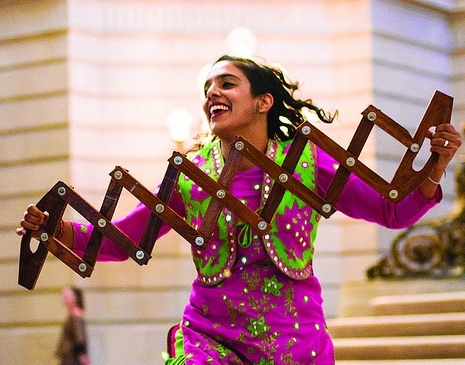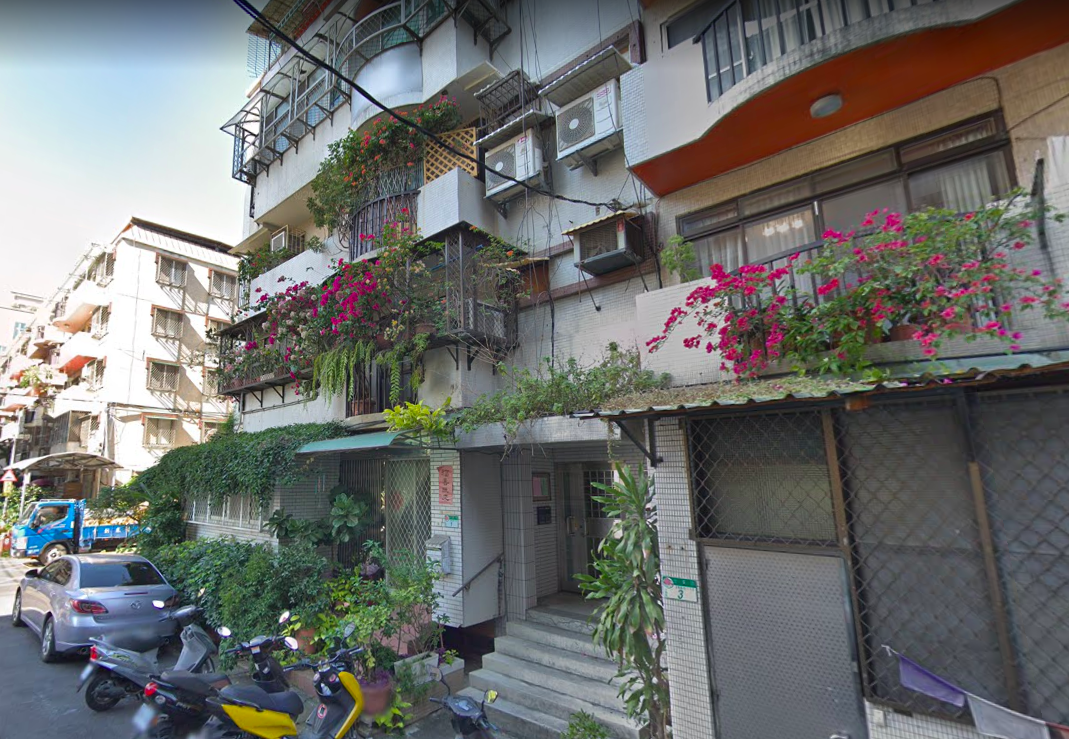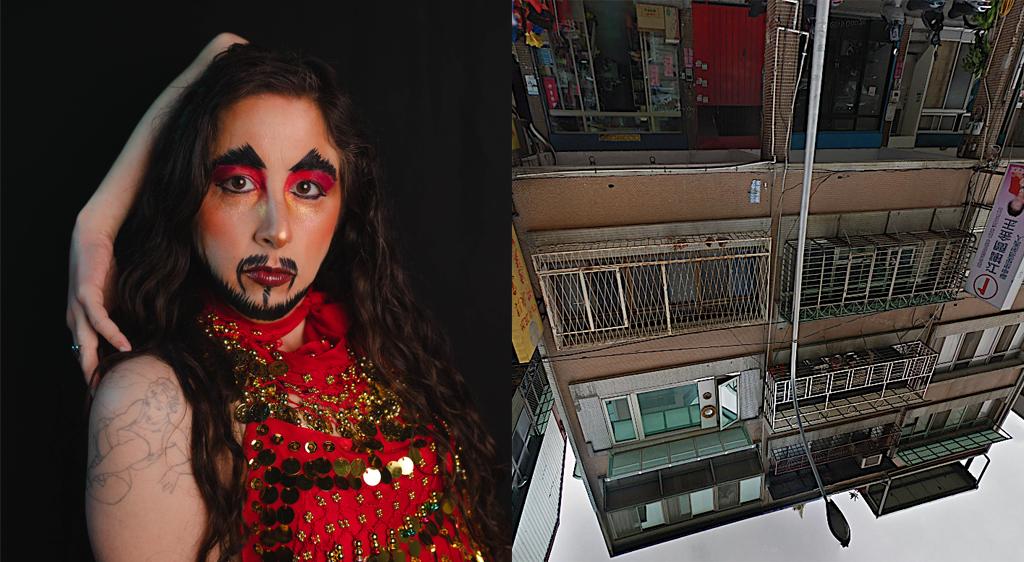Our final meeting for Performing Diaspora involved many tears. Emotions were palpable as artists spoke about having community for the first time, and staff expressed the fulfillment of a long-term vision. This has truly been a unique experience, and I feel emotionally and professionally bound to these people, many of whom I just met a few months ago. To be an artist and to be able to create your work, without worrying about paying for studio space, without worrying about hiring a lighting designer and paying for a theater, is a luxury. It shouldn’t be, but it is so rare for most dance artists to be supported in such a holistic sense. And to be in the company of such visionaries–including all the artists, staff, curators, and advisors–makes me feel like I am in a process of arriving!
I’m including here an article about my piece, by Joy Tang for Hyphen Magazine. Thanks to Joy for writing such a thorough and thoughtful review of the performance. Here is the link if you’d like to visit the blog: http://www.hyphenmagazine.com/blog/archive/2013/09/conversation-and-reflection-counterpulse-performing-diaspora-artist-joti-singh
Conversation and Reflection: CounterPULSE Performing Diaspora Artist Joti Singh

Joti Singh, creator and performer in Red, Saffron, and Green. Photo credit: Kegan Marling
With summer in San Francisco comes Performing Diaspora, presented through CounterPULSE Theater. A forum for traditional artists to experiment in their disciplines, artists create works that challenge the precepts of such cultural work (to paraphrase Marc Vogel of the Hewlett Foundation, a key funder of the program). This year, Performing Diaspora offered work from three Asian American artists.
I was fortunate to the view the thought-provoking work of Jia Wu and Joti Singh, as well as converse with each artist. Read our previous review of Jia Wu’s Mama/Medea here.
—
This week, we review Red, Saffron, and Green by Joti Singh, Artistic Director of Duniya Dance and Drum Company. Joti’s inspiration for this work-in-progress is her great grandfather, Bhagwan Singh Gyanee. From 1914-1920, Bhangwan was president of San Francisco’s Ghadar party, a party formed in 1913 for the purpose of fighting for India’s independence from Great Britain. Through original music (by Ishmeet Narula), Bhangra choreography, spoken word, and video, Joti and her collaborators tell, represent, and evoke Bhagwan’s story. The effect is a layered addition to our understanding of what it means to be American, Indian, and at home.
Throughout, Red, Saffron, and Green highlights its autobiographical underpinnings. Interwoven between several choreographies is a documentary in which Joti speaks about being a resident of San Francisco 100 years after her great-grandfather. Her current apartment is close to the Ghadar party’s original headquarters, and she experiences literally walking in her ancestor’s footsteps. In danced sections, choreography combines with spoken word material to illustrate Ghadar party precepts.
In one danced section, Joti and her two dance collaborators (Alysha Higgins and Priya Nyan) line-up stage left, facing the audience. Accompanied by Joti’s husband and collaborator, Guinean drummer Bongo Sidibe, each dancer proceeds laterally across the stage, their words punctuated by lifts and drops of their shoulders. As a viewer, I had a strange experience. Semantically, I reconceived the dancers’ shoulders as declarative statements, rather than as exclamations. I began to viscerally feel the application of Bhangra dance in a politicized narrative.
In our post performance interview, Joti confirmed that Bhangra’s history is not inconsistent its current popular practice. “Bhangra is fun,” she assured me, “It was celebratory, a harvest dance.” However, part of experimenting with Bhangra work, Joti explained, is not presenting it “with a smile.” I asked her, then, “Why Bhangra?” Joti explained:
I have been studying Bhangra since I was a kid. It is one of the ways my parents helped me stay connected to my roots and Punjabi culture. Therefore, it is the most appropriate vehicle for telling this story. It is my first language when it comes to dance. It is also Punjabi, and Bhangra is the expression of Punjab in dance… a part of Punjabi identity. It was danced during the Indian Partition [of 1947, during which the regions of Punjab and Bengali were divided between India and Pakistan.] Hindu and Sikh refugees coming over to the India side of the divide danced in their refugee camps… The story [of my great grandfather] is also very much this kind of story, one about nationhood and statehood and freedom and independence. Bhangra has that sort of history…
In short, Bhangra is an ideal container for her great grandfather’s story, and as a Bhangra dancer currently living in San Francisco, Joti is the ideal person to tell it. At once, Red, Saffron, and Green makes visible an under-reported period of Indian activism as well as the historical relevance and artistic flexibility of Bhangra as a movement genre. Finally, Joti’s autobiographical approach exposes invisible layers of accumulated geographic and personal identity, so common in hyphenated America. In Joti’s words, “Who we really are is far more interesting than our outside containers…The more time that goes by, the more layered everyone’s identity is becoming…” In Joti’s case, she also points out that her training in West African dance adds additional aesthetic layers to her own practice of Bhangra.
Joti finishes Red, Saffron, and Green by speaking, in both prose and poetry, about her great grandfather, whom she terms her “g.g.f.,” to great comic effect. She points to a picture of him on a table, where he, to paraphrase Joti’s words, poses with a sword where others might pose with their family. There is a sense of pride, but also of loss. Joti feels connected to his work, but she also knows her grandmother, while so proud of her father, did not not see him much. Joti told me that her grandmother did not see her father for over 40 years, while he was organizing. In our interview, I asked Joti, “Can you position your work for me, in terms of Asian Americans who perform work in diaspora. Why do we do this?” Her answer says it all:
One of the things that is important for me is [that] knowing this history… makes you realize and question where we are now, and where our struggle is… I feel inspired by this story to do something with my generation, with my fellow Asian Americans, and, more widely, I would say with people of color in this country. We have to realize that in the past 100 years, we’ve accomplished a lot. But, there’s a lot that hasn’t changed that much. Many of the struggles that these men faced were about not being able to become citizens because of color… We could be talking about today! These are the struggles and triumphs of our ancestors! Through this piece, I have felt, very strongly, an extension through my ancestry, behind and beyond myself. It is empowering to me, and we all need to feel empowered.
Red, Saffron, and Green manages to grapple with loss, longing, and family while rooting into shared work and ancestry. In addition, she proves Bhangra dance is available to us as a political performance language, given the appropriate narrative. Joti’s work-in-progress has finished its current run through CounterPULSE’s Performing Diaspora Program. But we can look forward to further iterations through her work with the American India Foundation.
– See more at: http://www.hyphenmagazine.com/blog/archive/2013/09/conversation-and-reflection-counterpulse-performing-diaspora-artist-joti-singh#sthash.muED9Llx.dpuf
Share This!
More Good Stuff
‘Border / Line خط التماس’ by Jess Semaan and Halim Madi & ‘Sa Ating Ninuno (To Our Ancestors)’ by Kim Requesto December 5-6 & 12-13,
Unsettled/Soiled Group is a group of East, Southeast, and South Asian diasporic movers, makers, and settlers on Ramaytush and Chochenyo Ohlone land. Unsettled/Soiled Group is led by June Yuen Ting, one of CounterPulse's 2022 ARC Performing Diaspora artists and will debut Dwelling for Unsettling alongside VERA!'s Try, Hye!, Thursday through Saturday, December 8-10 & 15-17, 2022
Try, Hye! by Vera Hannush/VERA! & Dwelling for Unsettling by Unsettled/Soiled Group December 8-10 & 15-17, 2022 // 8PM PT // 80 Turk St, SF



